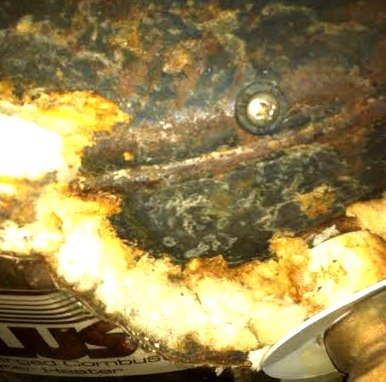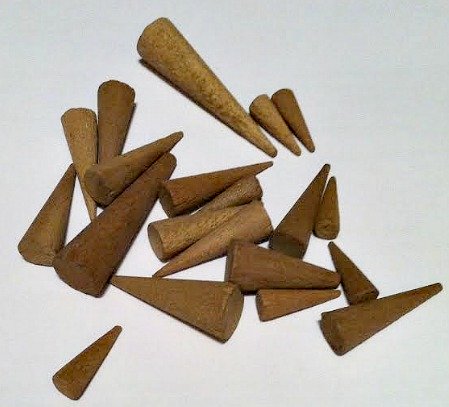Water Heater Tank
Inside the thin steel jacket you see on the exterior of your water heater, and under the insulation the jacket protects, is the iron tank of your water heater. It is the storage vessel itself and there is lots to know about it. The first and most fundamental thing to know is what it is made of. The water heater tank is iron of course, it is what we refer to as malleable iron. It is the same type of iron that gas pipe and galvanized water pipe are made of. The round sides are joined to the top and bottom of the tank by way of wire feed welded joints. The various threaded ports along with whatever lifting tabs, stiffeners, and standing supports the manufacture elects to add are also wire welded into place. The top of the tank is domed upward, the bottom of the tank is also domed upward. This design limits flexation and creates strength. In gas water heater tanks a vent tube is welded into the top and bottom so that it communicates between the two to form an exhaust pipe for the flame that will heat the water from below the tank. A twisted baffle is inserted down the entire length of this vent tube to slow and guide the hot air as it progresses toward the external vent piping.
Extending Water Heater Tank Life
Typically the inside of a water heater tank is then "glass lined". This glazing is similar to the glass you see on the cookware known as "Granite Ware". It keeps the water in the tank from having direct access to the iron and so prolongs the life of the tank. One would think that the glazing might have a significant impact on the longevity of the tank and at times it does, but for the most part the expansion and contraction the tank experiences over the term of its useful life cause enough fissures to appear in the lining to allow the water to get to the iron. In my opinion, the best way to preserve the integrity of the glass lining is to oversize the tank. Installing a tank one or even two sizes larger than your actual need reduces the the degree to which the internal environment of the tank changes. Reduce the amount of expansion and contraction and you will increase the expected lifetime of the lining. All of this is assuming the glazing is perfect and complete, which it may not be.
The issue of expansion and contraction also concerns the integrity of the welded tank seams. Movement at the seams, what I refer to as "work", is likely to cause any weaknesses or imperfections in the welds to breakdown and weep. The more work a joint experiences the shorter its useful life is apt to be. It is simply a question of metal fatigue. Once again an oversized tank which limits internal environmental changes will reduce the wear factor and therefore increase the longevity of the tank. Of course the trade off is that the more surface area the storage tank has the more energy it is apt to bleed to the environment. My concern here is not to discuss efficiency so much as it is to explain the physics involved it the technology.
Leaking Water Heater Tank
When a water heater tank leaks it my do so in a number of places. It may spring a leak at one of the many welded joints due to flaws in the welding or stress from being over used. More commonly though tanks spring leaks in their tops and sides. That is how they typically leak at the end of their normal lifetime, somewhere between twelve and fifteen years. The holes that develop in the iron tank are the same in formation and appearance as the holes that develop in galvanized pipe sections. The inner tank wall rusts till it is thin enough in one spot to seep from a tiny hole. That hole will rust closed in a matter of a few hours, perhaps a day. Other spots may weep as well but the same closing occurs, iron oxide takes up significantly more space than the metal does and the holes will continue to plug themselves for a while. Each time a hole erupts and throws off its clot of rust it becomes a larger hole. Eventually either one hole will become too large to rust closed or a small cluster of holes will blow out their central area.
One telltale sign of a weeping water heater is dried rust streaks under the edge of the jacket lid where it overlaps the side of the jacket. Water rises as steam and condenses on the inside of the lid. The lid is unpainted inside so any moisture makes rust right away. Then that rusty water seeps down out of the jacket joint. These marks are one of the things I look for when deciding whether to repair or replace a water heater.
It is worth noting here that nothing protects the outside of you water heater tank. Leaks from joints above the tank that drain down through the jacket can affect the longevity of your tank. Not all of them are as obvious as you might think, the hot tank can cause the dampness from small leaks to evaporate before the water appears at the floor. Inspect your heater's supply pipes from time to time. If you see lime deposits at fittings or jacket seems weeping has been or is continuing to be present.
Can You Fix a Leaking Water Heater Tank?
 |
 |
Here are a few things people used to do to get by when iron tanks or pipes leaked. On the left is an old water heater someone opened the jacket of to find the leak. That's a self tapping screw and a double aught bibb washer. They said it bought them a few more years. On the right are some wooden drive in pegs. One would drill the leaking hole round then drive in the peg. It would expand inside like a wine cork.